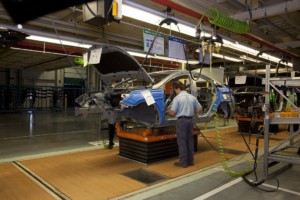 This is the last post on my short series on continuously moving assembly lines, where I will look at some special situations unique to the continuously moving assembly line. These lines have some interesting features for covering fluctuations within the line, for processing time that needs no worker or machine, and on the distance between parts on the line. Maybe some of these apply also to your situation and can help you to make your assembly line even better.
This is the last post on my short series on continuously moving assembly lines, where I will look at some special situations unique to the continuously moving assembly line. These lines have some interesting features for covering fluctuations within the line, for processing time that needs no worker or machine, and on the distance between parts on the line. Maybe some of these apply also to your situation and can help you to make your assembly line even better.
Continuously Moving Assembly
Continuously Moving Assembly Line—How to Do Line Balancing
 Continuously moving assembly lines have a lot in common with other types of assembly lines. However, there are also some differences. This third post of this small series on continuously moving assembly lines looks at how to distribute the work along the line. The key point is that you can distribute the work along the line in proportion to its duration, but the worker and the machines have to follow the takt time. Let me explain.
Continuously moving assembly lines have a lot in common with other types of assembly lines. However, there are also some differences. This third post of this small series on continuously moving assembly lines looks at how to distribute the work along the line. The key point is that you can distribute the work along the line in proportion to its duration, but the worker and the machines have to follow the takt time. Let me explain.
Continuously Moving Assembly Line—Speed, Work Content, and Length
 This second post on continuously moving assembly lines will look at the math behind the correlation between the speed of the line (line takt or customer takt), the length of the line, and the amount of work that has to be done on the line. Luckily, the calculations are not very tricky. And, different from a pulsed assembly line, it is perfectly fine to have a continuously moving line that fits not a whole number but a fraction of parts to save space. The tricky part on how to assign the work to the workers will be discussed in the next post of this series.
This second post on continuously moving assembly lines will look at the math behind the correlation between the speed of the line (line takt or customer takt), the length of the line, and the amount of work that has to be done on the line. Luckily, the calculations are not very tricky. And, different from a pulsed assembly line, it is perfectly fine to have a continuously moving line that fits not a whole number but a fraction of parts to save space. The tricky part on how to assign the work to the workers will be discussed in the next post of this series.
